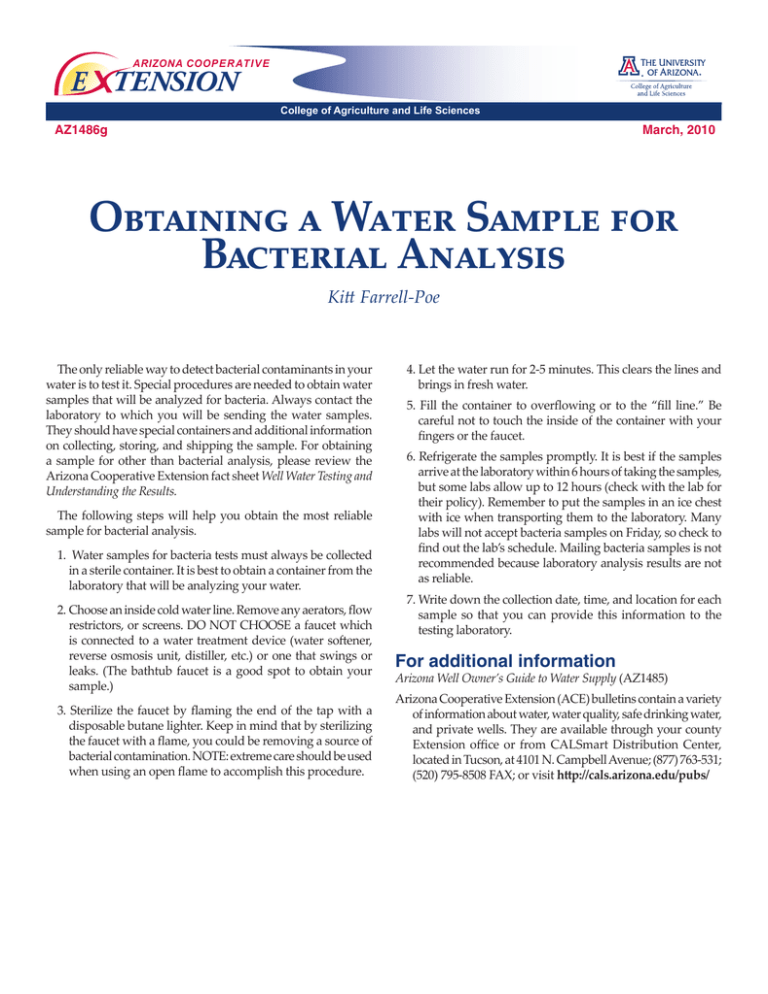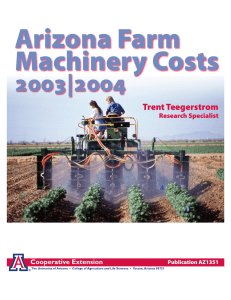Obtaining a Water Sample for Bacterial Analysis E TENSION
advertisement

ARIZONA COOP E R AT I V E E TENSION College of Agriculture and Life Sciences AZ1486g March, 2010 Obtaining a Water Sample for Bacterial Analysis Kitt Farrell-Poe The only reliable way to detect bacterial contaminants in your water is to test it. Special procedures are needed to obtain water samples that will be analyzed for bacteria. Always contact the laboratory to which you will be sending the water samples. They should have special containers and additional information on collecting, storing, and shipping the sample. For obtaining a sample for other than bacterial analysis, please review the Arizona Cooperative Extension fact sheet Well Water Testing and Understanding the Results. The following steps will help you obtain the most reliable sample for bacterial analysis. 1. Water samples for bacteria tests must always be collected in a sterile container. It is best to obtain a container from the laboratory that will be analyzing your water. 2.Choose an inside cold water line. Remove any aerators, flow restrictors, or screens. DO NOT CHOOSE a faucet which is connected to a water treatment device (water softener, reverse osmosis unit, distiller, etc.) or one that swings or leaks. (The bathtub faucet is a good spot to obtain your sample.) 3. Sterilize the faucet by flaming the end of the tap with a disposable butane lighter. Keep in mind that by sterilizing the faucet with a flame, you could be removing a source of bacterial contamination. NOTE: extreme care should be used when using an open flame to accomplish this procedure. 4. Let the water run for 2-5 minutes. This clears the lines and brings in fresh water. 5. Fill the container to overflowing or to the “fill line.” Be careful not to touch the inside of the container with your fingers or the faucet. 6. Refrigerate the samples promptly. It is best if the samples arrive at the laboratory within 6 hours of taking the samples, but some labs allow up to 12 hours (check with the lab for their policy). Remember to put the samples in an ice chest with ice when transporting them to the laboratory. Many labs will not accept bacteria samples on Friday, so check to find out the lab’s schedule. Mailing bacteria samples is not recommended because laboratory analysis results are not as reliable. 7. Write down the collection date, time, and location for each sample so that you can provide this information to the testing laboratory. For additional information Arizona Well Owner’s Guide to Water Supply (AZ1485) Arizona Cooperative Extension (ACE) bulletins contain a variety of information about water, water quality, safe drinking water, and private wells. They are available through your county Extension office or from CALSmart Distribution Center, located in Tucson, at 4101 N. Campbell Avenue; (877) 763-531; (520) 795-8508 FAX; or visit http://cals.arizona.edu/pubs/ ARIZONA COOP E R AT I V E E TENSION THE UNIVERSITY OF ARIZONA COLLEGE OF AGRICULTURE AND LIFE SCIENCES The University of Arizona College of Agriculture and Life Sciences Tucson, Arizona 85721 Kitt Farrell-Poe, PhD Water Quality Specialist Contact: Kitt Farrell-Poe kittfp@ag.arizona.edu This information has been reviewed by University faculty. cals.arizona.edu/pubs/water/az1486g.pdf Other titles from Arizona Cooperative Extension can be found at: cals.arizona.edu/pubs Any products, services, or organizations that are mentioned, shown, or indirectly implied in this publication do not imply endorsement by The University of Arizona. Issued in furtherance of Cooperative Extension work, acts of May 8 and June 30, 1914, in cooperation with the U.S. Department of Agriculture, James A. Christenson, Director, Cooperative Extension, College of Agriculture & Life Sciences, The University of Arizona. The University of Arizona is an equal opportunity, affirmative action institution. The University does not discriminate on the basis of race, color, religion, sex, national origin, age, disability, veteran status, or sexual orientation in its programs and activities. 2 The University of Arizona Cooperative Extension




